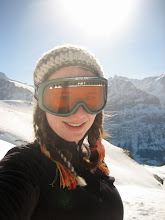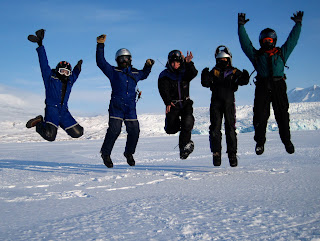Recipe for Disaster
Ingredients:
10 L Gasoline
1 leaky jerry can
1 sled with bad suspension
1 fast driver
120 km of rough terrain
1 large bag full of arctic survival gear (read: food, tent, sleeping bag, all of my warm technical clothing)
Mix. Best served at -25C and a 1-day drive away from 'civilization.'
Enjoy!
In other news, it's spring break! I've got a 3-week break in which to explore this beautiful island. The last two weekends have found me taking long snowmobile trips, while the weeks have been spent exploring local glaciers on skis (and yes, doing schoolwork too. It's not ALL fun and games up here).
Both weekends have involved exploring the area northeast of Longyearbyen: Templefjorden, Billefjorden, Pyramiden, and Tarantela. Pyramiden is an abandoned Russian mining town. Before 1998 it was a thriving coal-town of 1000+, but on January 10th 1998 it was abandoned virtually overnight without informing the local government or any of the surrounding communities. It is still unknown why the Russians left in such a hurry. Today there are 2 caretakers that 'ensure' that tourists don't get into any mischief (they don't do a very good job). What is left now is a virtually intact town that is perfect for exploring while singing creepy horror-movie tunes.
Unfortunately for me was the cooking of the 'Disaster' previously mentioned. I arrived in Billefjorden with gas soaked gear and food bags. Thankfully my friends were well prepared with extra food, and I kept warm enough at night by dressing like the Michelin Man in their extra clothes. I'm now feverishly researching methods of cleaning gas from down so that my sleeping bag and warm clothes survive the adventure. Anyone have any good tips? Till they're clean I'm stuck inside. My coursework and to-do list will probably thank that silly leaky jerrycan.
The highlight of the trips has been visiting two calving glacier fronts. When a glacier or ice sheet enters the ocean (or a lake) it fractures and large chunks of ice are able to fall into the ocean. This is a natural process that has been occurring for millennia, though rates of calving along some glaciers and ice sheets are accelerating (perhaps due to climate change). Calving fronts aren't the safest place to hang out and sight-see, but my inner glaciologist was dying for a close-up look. Right at the base of the glacier we found polar bear tracks!
About this Blog

- Kiya
- I'm an Oregon State University Earth Science major who will be spending January - June 2010 in Longyearbyen, Svalbard studying at UNIS, the University Center in Svalbard. I'm hoping to survive the darkness, cold, and polar bears long enough to share some stories about life and studies under the northern lights. I can be contacted at wilsokiy@onid.orst.edu











2 comments:
What a wonderful trip, even with the gasoline soaked part. I enjoy being there thru you.
Love Poppi
Wow! Adventures that leave your hair standing on end. Life just doesn't get better...gas spills and all.
Post a Comment